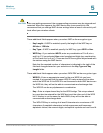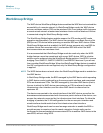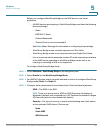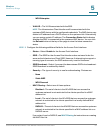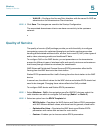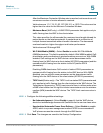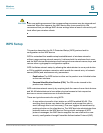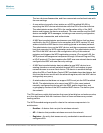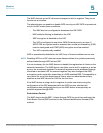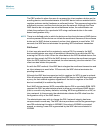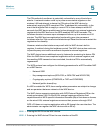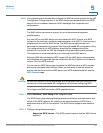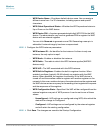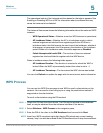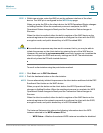
Wireless
WPS Setup
Cisco Small Business WAP551 and WAP561 Wireless-N Access Point 96
5
The two devices disassociate, and then reassociate and authenticate with
the new settings.
• A user wishes to enroll a client station on a WPS-enabled WLAN by
supplying the WAP device administrator with the PIN of the client device.
The administrator enters this PIN in the configuration utility of the WAP
device and triggers the device enrollment. The new enrollee and the WAP
device exchange WPS messages, including a new security configuration,
disassociate, reassociate, and authenticate.
• A WAP device administrator purchases a new WAP device that has been
certified by the Wi-Fi Alliance to be compliant with WPS version 2.0, and
wishes to add the WAP device to an existing (wired or wireless) network.
The administrator turns on the WAP device, and then accesses a network
host that supports the WPS registration protocol. The administrator enters
the PIN of the WAP device in the configuration utility of this external
registrar, and triggers the WPS registration process. (On a wired LAN, the
WPS protocol messages are transported through Universal Plug and Play,
or UPnP, protocol.) The host registers the WAP as a new network device and
configures the WAP with new security settings.
• A WAP device administrator has just added a new WAP device to an
existing (wireless or wired) network through WPS, and wishes to grant
network access to a new client device. The device is enrolled through
either the PIN or Push-Button Control (PBC) methods described above, but
this time the device enrolls with the external registrar, with the WAP device
acting solely as a proxy.
• A wireless device that does not support WPS must join the WPS-enabled
WLAN. The administrator, who cannot use WPS in this case, instead
manually configures the device with the SSID, public shared key, and
cryptography modes of the WPS-enabled WAP device. The device joins
the network.
The PIN is either an eight-digit number that uses its last digit as a checksum value,
or a four-digit number with no checksum. Each of these numbers may contain
leading zeroes.
The WPS standard assigns specific roles to the various components in its
architecture:
• Enrollee—A device that can join the wireless network.
• AP—A device that provides wireless access to the network.
• Registrar—An entity that issues security credentials to enrollees and
configures APs.



